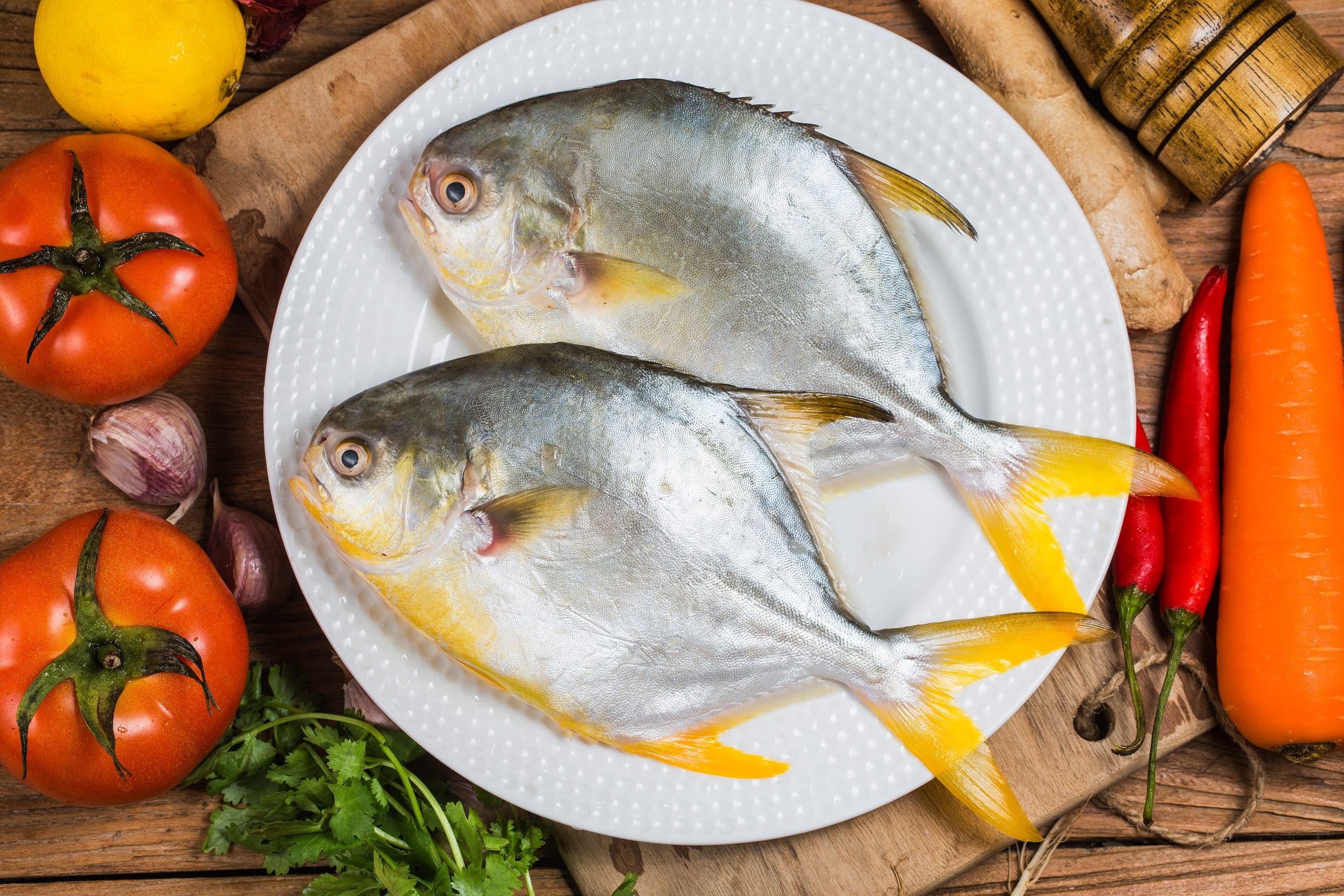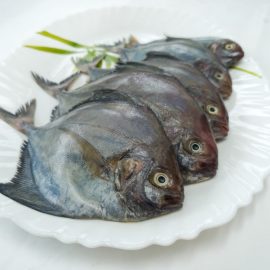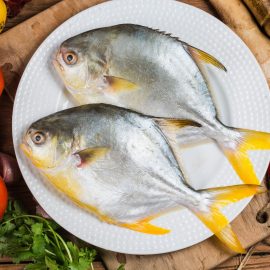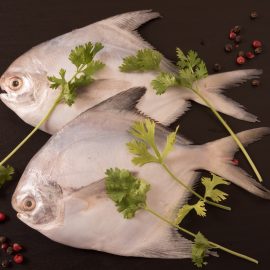
An Introduction to the Pomfrets
Pomfret is a family of deep-sea bony fish found in many parts of the world. There are many species of this saltwater fish in the Atlantic, Pacific and Indian oceans, and they range in size from small to large. With their compressed body shape and elongated pectoral fins, they form one of the world’s most abundant groups of fishes.
They are highly valued in many cuisines and are an essential part of the commercial seafood industry, prized for their delicate flavour and firm white flesh.
Description
The Pomfret is most commonly known for its soft, buttery flesh, often referenced in the name ‘Butterfish’, as well as its deep-bodied shape referred to as ‘Pompano’. These fish are found worldwide and commonly feature in seafood restaurants and dishes due to their delicate, aromatic flavour.
Several types of Pomfret include Black Pomfret, Silver Pomfret, and Butter Fish. The Black Pomfret is usually grilled or steamed; light sauces or spices often complement its more robust flavour. While the Silver Pomfret has a sweet flavour and light, delicate texture and is usually served with vegetables or salads. And the Butter Fish has a rich buttery taste with a smooth texture and is often employed in Thai and Indonesian cuisine.
Physical Characteristics
Pomfret is a species of deep-bodied and laterally compressed fish belonging to the family Bramidae. It is found in the coastal waters of the Atlantic Ocean, with specimens typically ranging in size from 20 to 40 centimetres (7.9 to 15.7 inches) and a maximum length of up to 50 centimetres (20 inches).
Pomfret have an elongated and cylindrical body with no scales, two dorsal fins, an anal fin, and two small pectoral fins at the back end. Its distinctive features include a laterally compressed form, a large and heavy head, an upturned mouth, a single sharp spine located just above the operculum, and long and slender pectoral fins.
They are considered to be some of the fastest fish in the sea, capable of reaching speeds up to 11.5 mph (18.6 km/h). Their swimming is characterised by the undulation of their body and caudal fin to propel themselves forward. They possess highly efficient gills for extracting oxygen from the surrounding water and a lateral line system to detect pressure, vibrations, and water movements.
Furthermore, Pomfrets communicate with one another through sound produced by their swim bladder, which can be used to attract mates, ward off predators, and coordinate group behaviour.
Distribution and Habitat
Pomfrets are benthic organisms that dwell near or on the ocean or lake floor. They can be found in sandy and rocky bottoms, including brackish and shallow freshwater habitats, in the South China Sea, Japan, Korea, Indian, and South Pacific Oceans, as well as the western coasts of North and South America. The species may also migrate seasonally to different regions for preferable food sources or better weather. Pomfrets typically travel up and down the water column with the change of season.
Pomfrets have adapted to live in a range of different environments. As well as being able to tolerate changes in temperature and salinity, they also need to be able to adjust their behaviour based on the photoperiod.
Fisheries and Uses
Physical Pomfrets are harvested commercially in India and other nearby countries using trawls, long lines, nets, and by hook and line, usually dried and packaged into natural baits for export worldwide.
Fisheries concerning Pomfret have the potential to influence both populations and ecosystems significantly. Fisheries management is a multifaceted issue involving various regulations, management practices, and sustainability initiatives to address environmental concerns, overfishing, and bycatch.
Population and Conservation
Conservation efforts and management regulations are necessary to ensure that Pomfret populations remain healthy and sustainable. Such measures include maintaining sustainable fishing practices, investing in protected areas and artificial reefs and implementing a catch limits system.
Furthermore, the population of Pomfrets comprises wild and farmed populations and can vary significantly depending on the geographical area, species and other factors. To preserve the Pomfret population, it is essential to assess the specific sustainability of the Pomfret in that location.
Conservation Status
The sustainability of Pomfret species is a complex issue as it involves wild and farmed populations, traditional fishing, and aquaculture. By investing in conservation efforts, managing these ecosystems and enforcing regulations, future generations can enjoy the abundance of this species.
Sustainable Fishing Practices
A sustainable approach to fishing is vital for preserving fish populations and their respective ecosystems. Initiatives and regulations are implemented to promote sustainability in fishing practices, such as enforcing management measures and implementing sustainable practices.
The sustainability of pomfret is an essential consideration in the fishing industry, with the future of the species relying on responsible fishing practices. Conservation efforts have been made in several areas to ensure the sustainability of Pomfret populations in the wild, with regulations being implemented to prevent overfishing.
For example, in India, the Ministry of Agriculture has implemented a ban on bottom trawling to reduce the number of pomfrets caught accidentally in bottom trawl nets. In addition, several initiatives are working to improve the sustainability of pomfret fishing.
Pomfret’s Diet
Pomfret are opportunistic creatures, able to feed in solitude and schools with other species. They are primarily benthic feeders meaning they feed on the seafloor or the bottom of the water column, consuming copepods, shrimps, amphipods and a variety of zooplankton. They have a highly-adapted structure and unique teeth on the upper and lower jaw, which allow them to swallow large prey items whole.
Reproduction
Pomfrets reproduce externally by cross-fertilisation, which involves two members releasing sperm and eggs to fertilise each other’s gametes. During a spawn, the female Pomfret lays many eggs, and the males externally fertilise them.
This process can result in thousands of larvae hatching in shallow water. The eggs are tiny and highly sticky, adhering to rocks and seaweed.
Spawning Habitats
In the wild, Pomfret migrate to shallow, nearshore waters during the breeding season. The larvae feed on plankton and crustaceans for the first few weeks before transitioning to a diet of small fish. This process continues at different life cycle stages until they reach maturity.
Life Cycle of Pomfrets
The average lifespan of an individual Pomfret in the wild is between 5-7 years. In captivity, they can live up to 10 years.
The optimum temperature range for this species is between 18-25, and males generally reach maturity earlier than females, usually between 1 and 2 years. Females typically take 3-4 years to reach maturity, and it is estimated that maximum egg productivity is achieved in 4-5 years.
Classification
The Bramidae family consists of two genera and many class species found in the Indo-Pacific, from Sri Lanka in the south to Japan in the east and the Persian Gulf in the northwest.
Physical Pomfrets are easily identified by their elongated upper profile and rounded ventral surface, measuring 40-50 cm in length with four distinct dorsal spines and a series of sharp ridges running along the middle.
Etymology
Pomfret is a family of bramid fish, distinct from various other related sea creatures. The name is derived from the Latin word pomum, which means apple, likely about the make and shape of the fish body.
French, Portuguese and Dutch versions of the word likely all derive from the same Latin root, and the English version, Pomet or Pomfret, was used frequently until the 19th century when the French name became the norm.
The Chinese and Japanese names for the Pomfret are ‘Tsung Jing’, ‘Cao Jing Feng’ and ‘Han Asai’, which also likely refer to its round body and a small head.
Culinary Value
Pomfret have considerable importance in the global fishing industry and are the basis for regional culinary recipes. They have a mild flavour and delicate white flesh, easy to cook.
Its subtle and delicate flavour is often complemented with sauces and other condiments to enhance its flavour. Its versatile nature also makes it an ideal ingredient for a wide range of dishes, making it a popular choice for seafood lovers.
Significance
Pomfret fish is a significant source of nutrition, contributing protein, minerals, and vitamins to our diets. This fish can be prepared differently, from baking and grilling to frying and steaming.
Pomfret portion is a popular and highly sought-after ingredient in many cuisines worldwide, with Southern Asia among the most frequent consumers. It is known for its firm and white or ivory flesh and is usually fried or grilled. Apart from being consumed, Pomfret has also been used in traditional medicines in some countries, such as India.
Popularity and Availability
Pomfret is a popular type of lightly-flavoured sea fish in temperate waters worldwide. Its delicate flesh has a mild sweetness and a white, flaky texture and is widely appreciated for its versatility in recipes from all over the world.
Whether fried, grilled or served as sushi, pomfret is a seafood delight that continues to be popular.
Nutritional Benefits of Pomfret
Pomfret is an excellent source of protein, vitamins and minerals, such as selenium, magnesium, phosphorus, zinc and potassium, which are all essential for good health. It is also high in omega-3 fatty acids, with significant amounts of EPA and DHA, which reduce inflammation, and insulin resistance and promotes a healthy heart.
Pomfret is also a good source of calcium, iron and dietary fibre while having a content of macronutrients similar to other types of fish. It is lower in sodium, fat and cholesterol than similar types of fish and has fewer calories, making it a healthier choice.
Moreover, Pomfret is a more sustainable option, meaning it is better for the environment than many other fish.
A Versatile Fish
Pomfret is a versatile fish that can be prepared in various ways to bring out its flavour. It is often served with sauces such as lemon or butter to enhance its flavour.
Pomfret can also be steamed, grilled, fried or baked to bring out different nuances of its flavour. The subtle taste of Pomfret compared to other species makes it an ideal ingredient in various dishes, allowing it to be enjoyed in combinations with multiple flavours.
Taste and Texture
Pomfret is an oily, firm-textured fish with a mild but distinctive flavour that is highly regarded in India. It has a subtle, slightly sweet taste, a delicate balance of sweetness and saltiness, and a mild flavour comparable to Mahi Mahi and other whitefish species.
The texture of Pomfret is firm, thick and succulent, with a flaky, buttery consistency, and it is often compared to Bohara, a fish similar to Tuna. People appreciate the delicate flavour of Pomfret, which is milder than other fish such as salmon, halibut, and tuna.
Cooking Pomfret
In the Indian subcontinent, Pomfret is commonly used in cooked dishes such as curries, stews and soups.
It is served deep-fried and battered in China and Japan as street food. It is often grilled in Vietnam with a special garlic and butter dipping sauce.
Pomfret is also served dried and salted and is often enjoyed with beer or rice wine. In the Philippines, it is served stuffed with kesong puti (a type of cheese) and bacon.
Preparation
Pomfret is typically prepared whole or in fillets. Before cooking, they should be washed and patted dry, then lightly rubbed with oil, butter, salt, and pepper.
For extra flavour, a marinade of oil, butter, herbs, spices, and a splash of citrus juice can be added.
It is important to use light oil or butter when pan-frying or grilling. In addition, you can steam Pomfret over vegetables like carrots and celery in thin slices.
Before deep-frying, lightly glaze the Pomfret with oil.
Side Dishes to Pair with Pomfret
The best side dishes to pair with a Pomfret dish depend on the flavour profile and the preparation of the Pomfret.
Roasted Pomfret can be served with various vegetables such as carrots, bell peppers, onions, asparagus and kale sauteed in garlic and olive oil, as well as spices and herbs thyme, parsley, shallots and garlic.
Roasted potatoes or Ratatouille are a great accompaniment to accompany shallow-fried or pan-fried Pomfret.
When steaming or serving Pomfret in a lighter dish, a side of light salad, such as a kale and quinoa salad or a couscous salad, as well as steamed vegetables or mashed potatoes, are ideal.
Sauces and Chutneys
For an extra flavorful accompaniment, tandoori or curry sauces are great to serve with Pomfret. Lemon butter or wine sauces are also great options to give the fish more flavour. It is possible to add another layer of taste with ingredients such as capers, tomatoes, olives, and capers.
For a classic finish, chutney or relish is the perfect accompaniment. Sauteed garlic, tomato, and onion chutney are great options, as the sweetness of the vegetables and the acidity of the tomato balance the flavour of the Pomfret. Pomfret goes well with a side of tartar sauce or remoulade.
It would be best to use spices and marinades sparingly to prevent overpowering this fish’s delicate flavour. You can create a sweet and spicy marinade with chilli powder, honey, lime juice, and coconut oil.
Cooking Techniques
Pomfret can be cooked in many ways, including baking, broiling, grilling, steaming, frying, and other methods such as stuffing, pan-frying, braising, and boiling.
Baking is best done by prepping the Pomfret as stated before, then placing it on a baking sheet and baking it at 400F for about 15-20 minutes.
When broiling, the same preparation steps apply to baking, but the fish should be placed under the broiler for around 8-10 minutes, flipping it halfway through.
Marinate the Pomfret with the mentioned oil and herbs, and then grill it over medium heat for 5-8 minutes per side.
Steaming can be as simple as placing the Pomfret on a tray with some vegetables and then steaming it at low heat for around 10 minutes.
Frying involves dredging the Pomfret in a flour-based batter and then frying it for about 3-5 minutes, flipping it halfway.
Popular Recipes
Due to its mild taste, Pomfret can be prepared in various creative and delicious ways. Here are some of the most popular recipes from around the world.
India
In India, some of the most popular recipes for pomfret include Tandoori Stuffed Pomfret, Fried Pomfret, Tandoori Pomfret Curry, Baked Pomfret and Masala Pomfret Fry. Masala Pomfret Fry is marinated in a spicy garlic and ginger paste, deep-fried, and garnished with lemon, coriander and chillies.
Lime-Marinated Pomfret is another popular preparation – it is marinated in a garlic, ginger and lime juice mixture before being grilled on skewers and served with grilled onions and tomatoes. Coconut Pomfret Curry is also famous, where pomfrets are cooked in a creamy coconut sauce flavoured with mustard seeds, curry leaves and red chillies.
China and Southeast Asia
In China and Southeast Asia, Steamed Pomfret is a popular dish. The fish is steamed with salted soybean paste, black bean sauce and Shaoxing rice wine to infuse the flavours into the pomfret.
Malaysia
In Malaysia, Grilled Pomfret with Turmeric Sauce is a typical recipe. The pomfret is marinated and then grilled before being served with spicy turmeric and chilli sauce.
United Kingdom
Ginger, Garlic, and Lemon Baked Pomfret is a popular dish in the United Kingdom. The pomfret is seasoned with ginger, garlic and lemon before being baked in the oven with butter or olive oil.
United States
Roasted Tomato and Pomfret Bake is a popular preparation. The pomfrets are mixed with garlic, oregano, and olive oil and topped with roasted tomatoes before being baked in the oven.
Cultural and Culinary Similarities/ Cultural uses
Pomfrets are a vital part of traditional diets in many parts of Asia and have been a source of nutrition for centuries. They are highly sought after for their pleasant flavour and nutritional value, making them a popular choice for many cultures.
Conclusion
Pomfrets are an essential part of the global seafood industry, with their delicate flavour and nutritional value being highly sought after. It pairs perfectly with various side dishes, from salads and stews to spiced dishes and curries.
The different types of Pomfret ensure its popularity will remain for centuries.
Conservation efforts are ongoing to ensure the sustainability of pomfret populations, allowing them to remain an important food source for many cultures worldwide.


